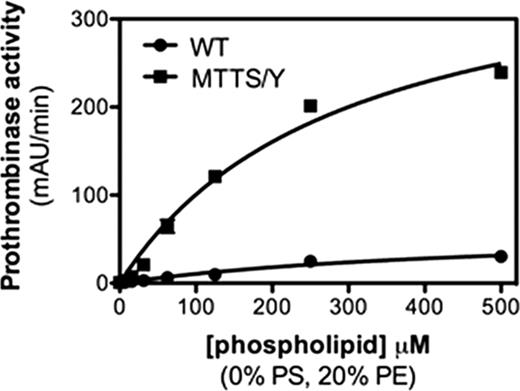Abstract
Abstract 2243
Toxicity of venom from the eastern brown snake (Pseudonaja textilis) is related to a prothrombin activator protein complex (pseutarin C) that is homologous to the factor Va/factor Xa complex. A previous study has found that the factor V-homologous subunit of this protein (pt-fV) is constitutively active and does not require anionic membranes to function (Bos et al. 2010, Blood). We have previously found that conservative mutation of the amino acids on the hydrophobic membrane binding regions (called spikes) of factor V (W2063M/W2064F/S2117L) can produce increased prothrombinase activity, increased membrane binding affinity and apparent phospholipid-independent prothrombinase activity. However, the membrane-independent activity is caused by retention of phospholipid by factor V through the purification process.
We hypothesized that the P.textilis venom-derived factor V has an increase in lipid affinity due to differences in the membrane-interactive spikes. Sequence alignment of the P.textilis venom-derived factor V with bovine and human factor V revealed 5 amino acids located in the putative membrane-binding region (four on spike 3 and one in a region targeted by a small-molecule inhibitor of membrane binding for both factor VIII and factor V) that differed in the venom-derived factor V versus the consensus sequence of mammalian factor V. A mutant factor V that incorporated these five mutations (L2116M, S2117T, S2118T, E2119S, and S2183Y) (factor VMTTS/Y) was expressed in COS cells. After purification utilizing ion exchange chromatography, factor VMTTS/Y showed phospholipid-independent activity that could be inhibited with phospholipase A2. Subsequently, factor VMTTS/Y was washed extensively with CHAPS during purification to prevent phospholipid from co-purifying. Activity was measured with a prothrombin time assay with plasma lacking factor V. Specific activity was 1183 units/mg vs. 676 units/mg for wild type human factor V. Steady state kinetics of the prothrombinase complex with factor VMTTS/Y were assessed with varying concentrations of phospholipid vesicles. In the presence of membranes containing excess phosphatidylserine (15:20:65 PS:PE:PC), factor VMTTS/Y (5 pM) showed 39% greater Vmax than wild type human factor V and 3-fold higher apparent membrane affinity. With limiting phosphatidylserine (2:20:78 PS:PE:PC), factor VMTTS/Y (10 pM) showed 64% greater Vmax and 2-fold higher apparent membrane affinity. Factor VMTTS/Y, purified with a CHAPS wash, did not show lipid-independent activity but did support prothrombinase activity on membranes lacking PS or other negatively charged lipid (20:80 PE:PC). On these vesicles factor VMTTS/Y (50 pM) had a Vmax that was 8-fold higher than wild type factor V (see figure).
No relevant conflicts of interest to declare.
Author notes
Asterisk with author names denotes non-ASH members.


